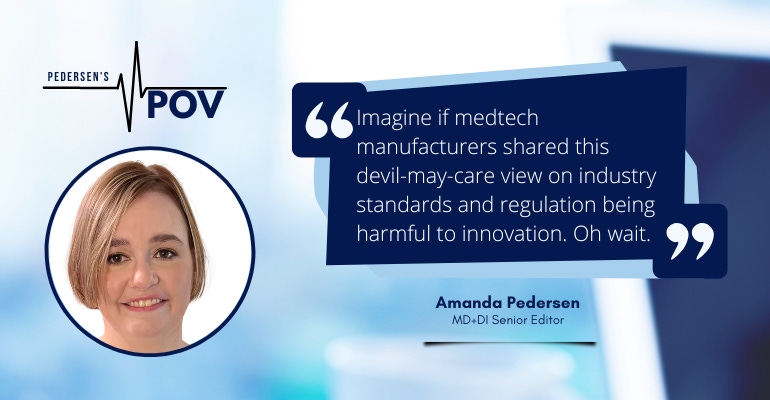Titanic Sub Tragedy Resurfaces an Age-Old Medtech Debate
This week in Pedersen’s POV, our senior editor explores the delicate balance of innovation and regulation in medical devices.
June 26, 2023

Four years ago, before most of us had ever heard of OceanGate or its Titan submersible that took deep-pocketed adventurists down to the RMS Titanic wreckage, the company published a blog post explaining why the vessel was not "classed" by an independent agency to assure that it met accepted industry standards.
"When OceanGate was founded, the goal was to pursue the highest reasonable level of innovation in the design and operation of manned submersibles," the company explained in the blog post. "By definition, innovation is outside of an already accepted system. However, this does not mean that OceanGate does [not] meet standards where they apply, but it does mean that innovation often falls outside of the existing industry paradigm."
The company went on to argue that certification would simply take too long, given the lack of pre-existing standards for OceanGate's innovations, such as carbon fiber pressure vessels and a real-time hull health monitoring system.
"Bringing an outside entity up to speed on every innovation before it is put into real-world testing is anathema to rapid innovation," according to the company. "For example, Space X, Blue Origin and Virgin Galactic all rely on experienced inside experts to oversee the daily operations, testing, and validation versus bringing in outsiders who need to first be educated before being qualified to ‘validate’ any innovations."
And a mere two years ago, OceanGate CEO Stockton Rush told CBS journalist David Pogue during an episode of Pogue's Unsung Science podcast, that, "You know, at some point, safety is just a pure waste. I mean, if you just want to be safe, don't get out of bed, don't get in your car, don't do anything."
Imagine if medtech manufacturers shared this devil-may-care view on industry standards and regulation being harmful to innovation. Oh wait.
The Titan submersible, or Titanic tour sub, dredges up an age-old medtech debate: do regulatory standards stifle innovation or promote safety? About a year ago, I wrote about the startling conclusions from a Medtech Europe survey on how the new Medical Device Regulation (MDR) is impacting innovation in the European Union. The survey quoted one medical device CEO as saying quite bluntly, "MDR is killing innovation."
Over the years FDA has been on the receiving end of similar accusations with regards to medical innovation in the United States. As George Samaras, a biomedical scientist and engineer who has experienced FDA regulation from both the inside and the outside, noted in an opinion article he wrote for MD+DI back in 2011 on the medical device innovation versus regulation debate, regulation demands modern engineering practices, including design controls and risk management for hardware, software, and human factors; accountability, such as complaint handling and medical device reporting; and, he wrote, "it is believed to be slow to complete clearances and approvals."
According to Samaras, the argument that FDA is too slow is almost always without merit.
"I have seen PMA, IDE, and 510(k) submissions from the inside and from the outside (both from clients and during discovery as an expert witness)," Samaras wrote. "The ones that did (or should have) encountered problems actually had defects in the submissions: ignorance or misunderstanding of FDA regulations, consensus standards, and guidance documents; missing or defective elements such as risk analyses, software documentation, human factors testing, no clue what engineering verification or engineering validation really mean, or defective biostatistical test designs and analyses; and, in a small number of cases, misrepresenting the facts, not withstanding a declaration that the submission was truthful, accurate, and complete."
In other words, regulation didn't slow down these innovations, but rather the technology's time-to-market was ultimately slowed by the medical device manufacturer's attempts at taking shortcuts. But the real problem, as I see it, is that these shortcuts are all-too-often missed during the regulatory process and don't surface until long after the device has been put on the market and enough adverse events are reported to warrant a recall.
Take, for instance, the Dalkon Shield, a birth control device from the 1970s that played a key role in medical device regulation reform. Specifically, this device highlighted the need for medical device reporting of adverse patient events (and the dangers of under-reporting and inaccurate claims by manufactures).
Manufactured by a company no longer in business, A.H. Robins, the Dalkon Shield hit the U.S. market in 1971 and was promoted as a safer alternative to birth control pills. At its peak, roughly 3 million women used the device in the United States. But the Dalkon Shield became infamous for its most serious design flaw: a porous, multifilament string upon which bacteria could travel into the uterus of users, leading to sepsis, injury, miscarriage, and death.
A somewhat more recent example is the breast implant scandal in Europe in which roughly 40,000 European women received breast implants made from industrial-grade silicone, triggering cries for medical device regulatory change.
While there is something to be said for the "move fast and break things" mantra, I've seen too many controversial medical devices reach the market to believe that regulation stifles innovation. Indeed, many life-saving devices would reach patients years earlier if manufacturers didn't have to jump through so many regulatory hoops – but what about all the potential harm that has been prevented by design standards and regulation?
The OceanGate tragedy is a bit different in the sense that the passengers who died on the Titan surely knew they were gambling with their lives when they signed the consent forms and shelled out $250,000 to see the Titanic wreckage. But if Rush hadn't had such a reckless attitude toward industry standards and regulation – if he hadn't considered safety to be a "pure waste" – he and his fellow passengers might not have met such a tragic fate.
About the Author(s)
You May Also Like



.png?width=300&auto=webp&quality=80&disable=upscale)
